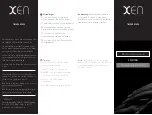
© HAMILTON 2005 / KHAKI AUTOMATIC X-WIND
5
4
© HAMILTON 2005 / KHAKI AUTOMATIC X-WIND
Chronograph functions
–
First push of start/stop button (
2
) starts chronograph hand and counters.
–
Second push of start/stop button (
2
) stops chronograph hand and counters.
–
Subsequent operation of start/stop button (
2
) starts and stops the chronograph as many times as required
to measure a total time.
–
Pushing reset button (
3
) resets the chronograph hand and counters to zero.
Crosswind
1.
Position the red arrow of the upper interior rotating bezel (
C
) at
12 o'clock
by adjusting with crown (
B
).
Adjust the lower interior rotating bezel (
E
) to
0°
by adjusting with crown (
D
).
2.
Obtain
wind speed
and
direction
from control tower or weather chart.
Ex.
Wind speed
:
40
mph
Wind direction
: 70°
Indicate
wind direction
(70) in the window with the upper interior rotating bezel (
C
) by adjusting with crown
(
B
).
3.
Adjust the exterior rotating bezel (
A
) so that one tenth of the speed of the aircraft is indicated opposite the
red arrow.
Ex.
Aircraft speed
: 180 mph – indicate
18
.
4.
From the geographical bearing, calculate the
magnetic bearing
of the aircraft:
The variation (Var) depends on the current location, which can be determined from an aviation chart.
If the variation (Var) is to the West, it is added to
the geographical bearing to obtain the magnetic
bearing. Ex. 30° + 10° = 40°
If the variation (Var) is to the East, it is subtracted
from the geographical bearing to obtain the
magnetic bearing. Ex. 30° - 15° = 15°
Tn: True North | Mn: Magnetic North | Var: Variation
Ex. Geographical bearing: 30°
Variation (Var): 10°
Magnetic bearing
: 30° + 10° =
40°























